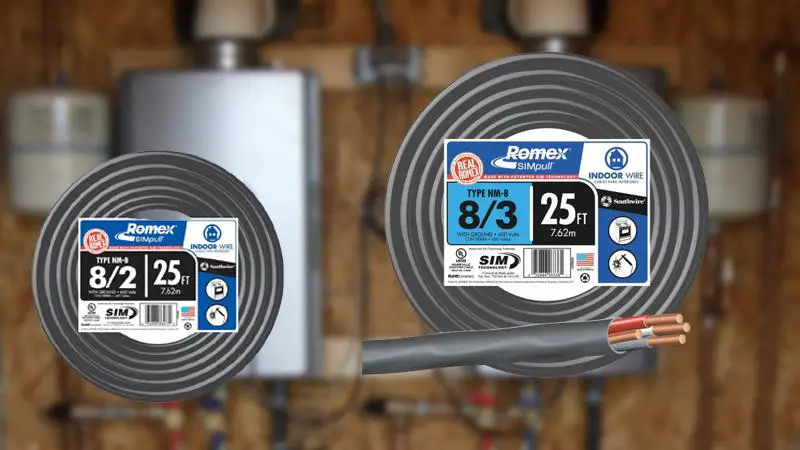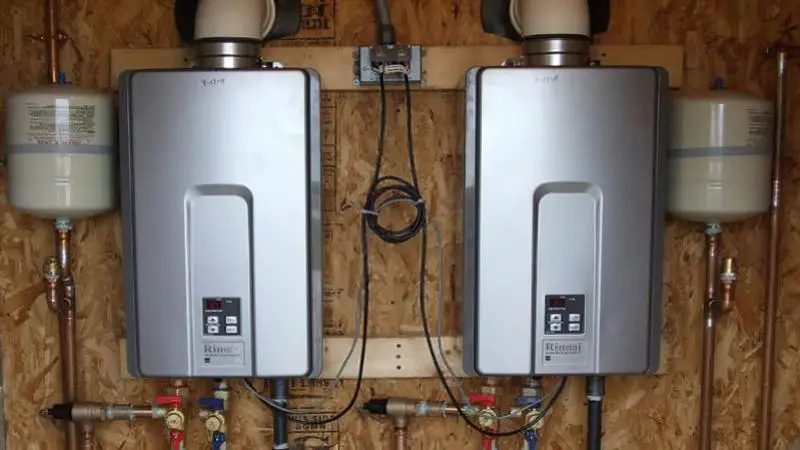8/2 or 8/3 Wire for Tankless Water Heater

Choosing the correct wire size and type for a tankless water heater installation is essential for ensuring the safe and efficient operation of your system. The electrical load of a tankless water heater can be significant, and it is important to choose a wire size and type that can safely and reliably carry this load without overheating or becoming damaged.
In addition to safety, choosing the appropriate wire size and type can also affect the performance and efficiency of your tankless water heater. If the wire size is too small, it may become overloaded and cause the heater to perform poorly or even shut off entirely. On the other hand, if the wire size is too large, it may be unnecessarily expensive and difficult to install.
To ensure that your tankless water heater is installed safely and performs at its best, it is important to carefully consider the appropriate wire size and type for your installation. In this article, we will discuss the basic concepts of wire size and type, how to calculate the electrical load of your tankless water heater, and how to use the National Electrical Code (NEC) to determine the appropriate wire size and type for your installation.
You'll Learn About
8/2 and 8/3 wires, Meanings and Differences
8/2 and 8/3 wire are types of electrical cable that are commonly used in residential and commercial wiring applications. These cables are made up of two or three conductors, respectively, encased in a protective outer jacket.
8/2 wire is a cable that contains two conductors, each with a gauge size of 8. This wire is often used for heavy-duty electrical circuits, such as those that power large appliances or electrical systems with high electrical loads.
8/3 wire, on the other hand, contains three conductors with a gauge size of 8. This type of wire is often used for multi-wire circuits, where two or more circuits are run together in the same cable.
| Properties | 8/2 Wire | 8/3 Wire |
| Number of Conductors | 2 | 3 |
| Gauge Size | 8 | 8 |
| Maximum Electrical Load | 40 amps (9600 watts) | 30 amps (7200 watts) |
| Pros | Capable of carrying high electrical loads, suitable for heavy-duty circuits | Allows for multiple circuits in the same cable, more flexible and easier to install |
| Cons | Relatively thick and inflexible, can be more expensive | Not as capable of carrying high electrical loads, can be more expensive |
8/2 wire contains two conductors with a gauge size of 8, while 8/3 wire contains three conductors with a gauge size of 8. 8/2 wire is capable of carrying higher electrical loads than 8/3 wire but is also thicker and more inflexible. 8/3 wire, on the other hand, allows for multiple circuits in the same cable but is not as capable of carrying high electrical loads as 8/2 wire.
Pros and Cons of 8/2 Wire
One advantage of using an 8/2 wire is that it is capable of carrying a high electrical load without overheating or becoming damaged. This makes it suitable for use in circuits that power large appliances or other electrical systems with high electrical demands.
However, 8/2 wire is also relatively thick and inflexible, which can make it difficult to install in tight or confined spaces. In addition, the cost of 8/2 wire can be higher than other types of the electrical cable due to the larger size of the conductors.
One advantage of using 8/3 wire is that it allows for multiple circuits to be run in the same cable, which can save space and simplify the wiring process. In addition, 8/3 wire is typically more flexible and easier to install than 8/2 wire, which can make it a better choice for certain applications.
However, the fact that 8/3 wire contains three conductors instead of two means that it is not as capable of carrying high electrical loads as 8/2 wire. This means that it may not be suitable for use in circuits that power large appliances or other electrical systems with high electrical demands. In addition, the cost of 8/3 wire can be higher than other types of the electrical cable due to the additional conductor.
Calculating your electrical load
Determining the electrical load of your tankless water heater is an important step in choosing the correct wire size and type for your installation. The electrical load of a tankless water heater is typically measured in kilowatts (kW) and can be found in the specifications provided by the manufacturer.
To calculate the electrical load of your tankless water heater, you will need to multiply the voltage of the heater by the amperage of the heater. For example, if your tankless water heater has a voltage of 240 and an amperage of 50, the electrical load would be calculated as follows:
240 volts x 50 amp = 12,000 watts (12 kW)
Once you have determined the electrical load of your tankless water heater, it is important to choose a wire size that can accommodate this load. The National Electrical Code (NEC) provides guidelines for determining the appropriate wire size for a given electrical load. Generally, a wire size of 8 gauge is suitable for electrical loads up to 40 amps, while a wire size of 6 gauge is suitable for electrical loads up to 60 amps.
It is important to choose a wire size that is capable of carrying the electrical load of your tankless water heater without overheating or becoming damaged. If the wire size is too small, it may become overloaded and cause electrical fires or other hazards. On the other hand, if the wire size is too large, it may be unnecessarily expensive and difficult to install. It is always best to consult a licensed electrician or the manufacturer of your tankless water heater for guidance on choosing the appropriate wire size and type for your installation.
Determining the Correct Wire Size
The National Electrical Code (NEC) is a set of standards and guidelines that are used to ensure the safe installation and operation of electrical systems. The NEC provides specific recommendations for determining the appropriate wire size for a given electrical load.

To determine the correct wire size for your tankless water heater installation, you will need to first determine the electrical load of your tankless water heater, as described in the previous answer. Once you have determined the electrical load, you can use the NEC’s ampacity tables to determine the appropriate wire size.
The ampacity tables provide information on the maximum amount of current that a given wire size can safely carry under various conditions. For example, a wire size of 8 gauge is typically suitable for electrical loads up to 40 amps, while a wire size of 6 gauge is suitable for electrical loads up to 60 amps.
It is important to consult the NEC’s ampacity tables for the specific conditions of your installation, as the appropriate wire size may vary depending on factors such as the length of the wire run, the ambient temperature, and the type of insulation used on the wire. It is always best to consult a licensed electrician or the manufacturer of your tankless water heater for guidance on choosing the appropriate wire size and type for your installation.
Other Considerations
There are several other factors that can affect your choice of wire size and type for a tankless water heater installation. These factors include local building codes, the distance of the wire run, and the type of electrical circuit.
Local building codes can provide specific requirements for the wire size and type that must be used in a given installation. It is important to check with your local building department or a licensed electrician to determine the requirements that apply to your installation.
The distance of the wire run can also affect your choice of wire size and type. As the length of the wire runs increases, the resistance of the wire also increases, which can cause the wire to heat up and become damaged. To compensate for this, larger wire sizes may be required for longer wire runs.
Finally, the type of electrical circuit can also affect your choice of wire size and type. For example, a circuit that powers a large appliance or electrical system with a high electrical load may require a larger wire size than a circuit that powers a small appliance or electrical system with a low electrical load.
In general, it is always best to consult a licensed electrician or the manufacturer of your tankless water heater for guidance on choosing the appropriate wire size and type for your installation. They will be able to provide specific recommendations based on the specific conditions of your installation.
Frequently Asked Questions
- Can I use 8/2 wire for a tankless water heater installation?
Yes, 8/2 wire is a suitable choice for a tankless water heater installation. This type of wire contains two conductors with a gauge size of 8, which is capable of carrying high electrical loads without overheating or becoming damaged. However, 8/2 wire is also relatively thick and inflexible, which can make it difficult to install in tight or confined spaces.
- Is 8/3 wire suitable for a tankless water heater installation?
8/3 wire is not typically recommended for a tankless water heater installation. This type of wire contains three conductors with a gauge size of 8, which is not as capable of carrying high electrical loads as an 8/2 wire. In addition, the fact that 8/3 wire contains three conductors instead of two can make it more expensive and difficult to install.
- What is the maximum electrical load that an 8 gauge wire can handle?
According to the National Electrical Code (NEC), an 8 gauge wire is typically suitable for electrical loads up to 40 amps. This means that an 8 gauge wire can safely carry a maximum electrical load of 9600 watts (240 volts x 40 amp = 9600 watts).
- Can I use a smaller wire size for a tankless water heater installation?
It is not recommended to use a smaller wire size for a tankless water heater installation. The electrical load of a tankless water heater can be significant, and it is important to choose a wire size that can safely and reliably carry this load without overheating or becoming damaged. Using a smaller wire size than recommended by the NEC can pose a safety hazard and may cause your tankless water heater to perform poorly or shut off entirely.
Use the correct wires, otherwise, your water heater might get problems.
Final Words
Choosing the correct wire size and type for a tankless water heater installation is an important step in ensuring the safe and efficient operation of your system. To determine the appropriate wire size and type for your installation, you will need to consider factors such as the electrical load of your tankless water heater, local building codes, the distance of the wire run, and the type of electrical circuit.
The National Electrical Code (NEC) provides guidelines for determining the appropriate wire size for a given electrical load. In general, a wire size of 8 gauge is suitable for electrical loads up to 40 amps, while a wire size of 6 gauge is suitable for electrical loads up to 60 amps.
It is important to consult a licensed electrician or the manufacturer of your tankless water heater for guidance on choosing the appropriate wire size and type for your installation. They will be able to provide specific recommendations based on the conditions of your installation and ensure that your electrical system is installed safely and in compliance with all applicable codes and standards.
